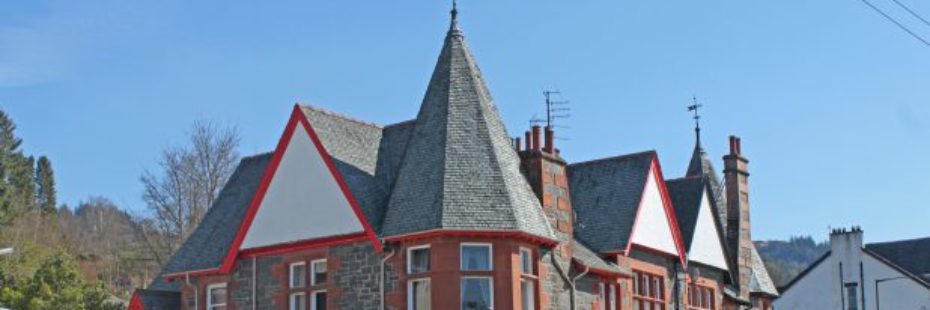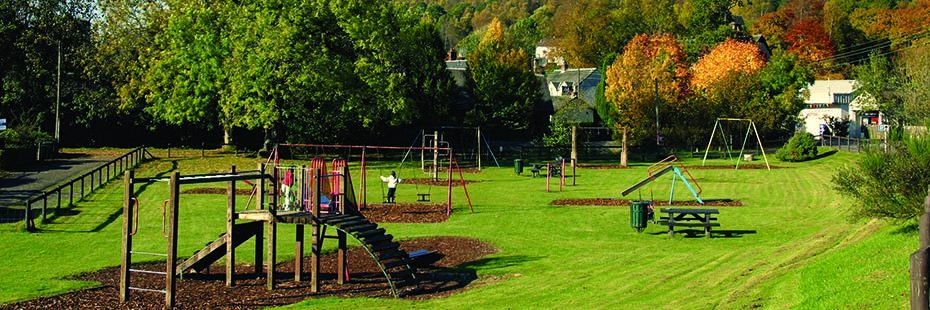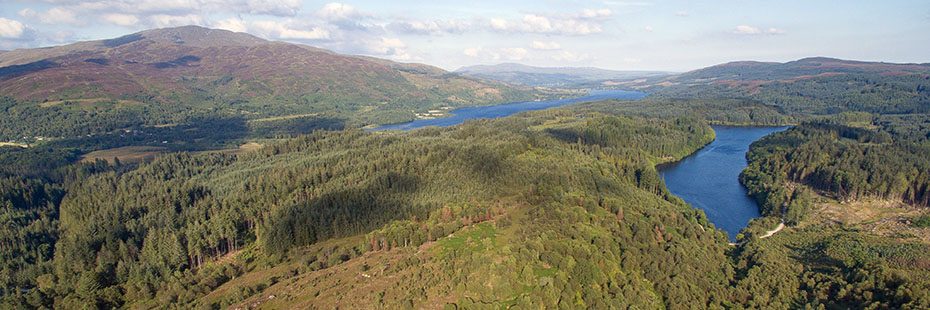
Aberfoyle
Aberfoyle is a charming village on the banks of the River Forth in the magnificent Queen Elizabeth Forest Park. The village, once important for its slate quarries, quickly developed into the southern gateway of The Trossachs following the publication of Walter Scott’s ‘The Lady of the Lake’. Today, its distinct Victorian architecture remains a feature of the village.

Victorian architecture in Aberfoyle
Aberfoyle is a popular holiday village with an attractive main street, well served by shops, cafés and restaurants.
You can learn more about the area’s natural beauty and history at the Trossachs Discovery Centre, within the VisitScotland iCentre.
Nearby is the Scottish Wool Centre, which tells the full story of wool, from sheep to the shops, through live sheep shows and hands-on demonstrations of spinning and working sheepdogs. The village also boasts one of the most scenic golf courses in Scotland, the Aberfoyle Golf Club. This James Braid designed heathland course was established back in 1890.
The Doon Hill mystery
The Reverend Robert Kirk was a minister in Aberfoyle. In 1691 he published his famous book The Secret Commonwealth of Elves and Fairies. It was subtitled ‘an essay of the nature and actions of the subterranean (and for the most part) invisible people heretofore going under the names Elves, Fauns and Fairies’. Not long after that he mysteriously disappeared.
Like most people in the 17th century he believed in witchcraft, spirits and pagan rituals. In fact he was so obsessed by the study of fairies (known as Urisks) that he described their appearance, ways, habits and secrets in his book. That was probably his big mistake. Local people believe that by revealing their closely guarded secrets, he annoyed the spirit people and they killed him. The ‘murder’ took place on Aberfoyle’s Doon Hill, which is a strange, knoll-like mound. The Reverend’s body was found there on 14 May 1692, dressed only in a nightgown.
You can walk up to the top of Doon Hill from the town. Look for an ancient pine in the middle of a clearing. It’s thought to be a doorway to an underground Fairy Queen’s palace, where Robert Kirk’s soul is still held captive.

Aberfoyle Park
An ideal base to explore the National Park
There are a number of local paths that start from the main car park and range from short strolls in the vicinity of the village to more demanding hill walks further afield.
To the east of the village on the minor road to Inversnaid is Loch Ard, which is home to many outdoor activities including water sports, many walking trails such as the Loch Ard Sculpture trail, and fishing opportunities with permits available locally. The Duke’s Pass is the direct route from Aberfoyle into The Trossachs and is regarded as one of Britain’s best drives. Taking the motorist over the hills in a series of sweeping curves, and with spectacular views of the lochs, woods and hills beyond, it provides anticipation of the Highland landscape to come. Named after Rob Roy’s arch rival, the Duke of Montrose, it follows the route once followed by Rob Roy’s cattle drovers and, after the construction of the road in 1886, by the horse-drawn carriages of 19th century tourists.

The Trossachs, with Ben Ledi, Loch Venachar and Loch Drunkie
Further north along Duke’s Pass there is a turning eastward to the Three Lochs Forest Drive a 7¼ mile (11.5 km) loop open to walkers, cyclists and drivers. Along the drive visitors can stop to explore further afield along short, easy trails or stop for a picnic site beside peaceful Loch Drunkie. There are also accessible toilets and play features there too.
The Forest Drive winds its way through the breathtaking Trossachs scenery past three picturesque lochs – Lochan Reòidhte, Loch Drunkie and Loch Achray. There is always the chance of spotting woodland and watery wildlife too. Glimpse deer amongst the trees, listen for the chatter of woodland birds and red squirrels and if you’re really lucky, spot an osprey fishing on one of the lochs.
The Forestry Commission Scotland’s The Lodge Forest Visitor Centre is also worth a visit. Here visitors can get up close to a wide range of wildlife with live CCTV viewing and a red squirrel viewing hide. The mixed woodlands provide a beautiful setting for over 60 miles of forest walks, drives, cycle tracks and picnic and play areas. Or, if you’re feeling adventurous, take in the stunning surroundings of the Queen Elizabeth Forest Park as you fly 46 metres above the ground on two of Britain’s longest zip wires at Go Ape.
Explore the Forest Lodge paths with Google Street View
Pitch-up
If you’re feeling adventurous why not go camping and be at one with the great outdoors? Camping is a great way to enjoy the National Park and three lochs forest drive offers stunning surroundings. If you fancy a wild camping experience, be sure to familiarise yourself with the Park’s Camping Management Zones before you go and get your permit if you’ll be pitching-up in one of our designated permit areas.
Did you know?
In the past Aberfoyle was spelt alternatively as “Aberfoil”.
Find out more…
- If you wish to find out more about the local Aberfoyle community and the work they do
- Aberfoyle, Kinlochard and Inversnaid have produced a Local Community Plan for 2008-2011, which offers further information on what it is like to live in these villages, the aspirations and priorities for the future of the local community and how they will be achieved.
- Friends of Loch Lomond’s webpage offers further information on the natural and cultural heritage of Aberfoyle and the surrounding Trossachs.
- Camping at Loch Ard and the Three Lochs Forest Drive.

